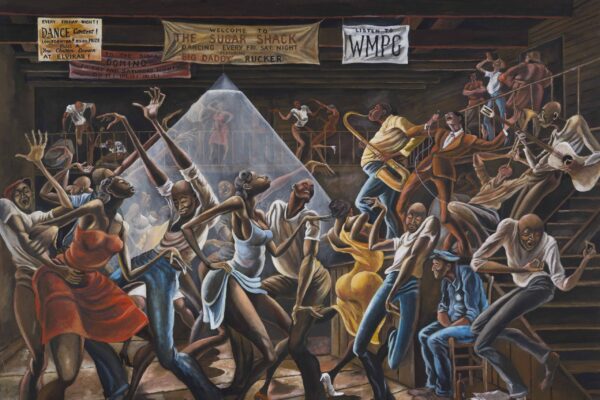AUSTIN, Texas — Former NFL football player Ernie Barnes based “The Sugar Shack” on a childhood memory of sneaking into the Durham Armory in 1950s North Carolina. “It was the first time my innocence met with the sins of dance,” he said in 2008. This legendary venue, which still exists today, hosted segregated dances and musicians such as Duke Ellington. For Barnes, it set the stage for what has become one of the most famous paintings in the country.
Thanks to a generous loan from the painting’s owners, Houston collectors Bill and Lara Perkins, visitors can see Barnes’ masterpiece on view at the Blanton Museum of Art at The University of Texas at Austin now through Nov. 10, 2024.
Featuring elongated figures dancing and playing music in a crowded Black music hall, Barnes’ “The Sugar Shack” became a Black cultural icon after the first version was featured on the cover of Marvin Gaye’s 1976 album “I Want You.” That same year, Barnes created a second version that garnered wider fame when it was added to the end credits of the groundbreaking 1970s sitcom “Good Times,” one of the first TV shows to focus on a Black family. The first version belongs to actor and comedian Eddie Murphy. The second version, now at the Blanton, was acquired by Bill Perkins in 2022 at a record-smashing auction that made headlines and renewed interest in Barnes’ work.
“‘The Sugar Shack’ is an American cultural touchstone,” said Carter Foster, the Blanton’s deputy director for curatorial affairs. “I hope visitors to the Blanton are inspired by this extraordinary painting and make connections to its social and art historical importance.”
Barnes is known for centering Black life in his dynamic, energetic paintings filled with expressive figures, often with closed eyes — a practice that, in his own words, illustrated how “we are blind to one another’s humanity.” At the Blanton, Barnes’ “The Sugar Shack” appears in dialogue with exemplary earlier works of social realism from the museum’s collection of American art, including Philip Evergood’s “Dance Marathon” and Thomas Hart Benton’s “Romance.” Like Barnes’ masterpiece, they document everyday life and offer social commentary.
“It’s one of our visitors’ favorite galleries in the museum, and heavily used in teaching,” Foster said. “We knew ‘The Sugar Shack’ would fit right in, and we’re excited for the new conversations it will spark.”




